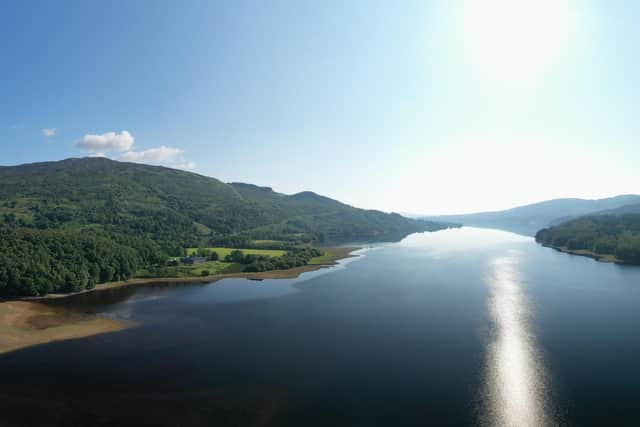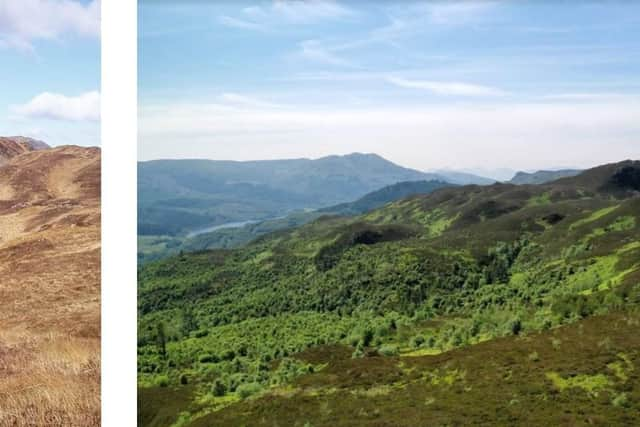Rewilding: ‘Before’ and ‘after’ pictures show transformation of Scottish glen into wildlife haven and visitor hotspot
Glen Finglas estate was a hill farm that had been heavily grazed by sheep when it was taken over by the Woodland Trust charity a quarter of a century ago.
Now, after extensive work to plant trees and repair peatlands, it is a thriving wildlife site, home to myriad species - including black grouse, beavers, golden eagles, pine martens, otters and red squirrels.
Advertisement
Hide AdAdvertisement
Hide AdThe charity acquired Glen Finglas estate, which is part of the Great Trossachs Forest National Nature Reserve, in 1996 - with help from the National Lottery Heritage Fund.


Covering more than 4,800 hectares of mountain and moorland, it is the largest of the Woodland Trust’s 1,200 sites across the UK.
This metamorphosis has required careful management of the vast and varied landscape to protect and enhance a host of habitats, from open and ancient oak forests through to montane scrub, grasslands, marshes and moors.
Over the years more than one million native trees have been planted at the site, creating some 1,800 hectares of new woodlands.
Around 100 hectares of peatland has been brought back to a healthy condition through rewetting and reprofiling of damaged bogs.


Open areas, including rare upland forest pasture land, are managed by a hardy herd of grazing Luing cattle.
All this has seen nature thrive and transformed what was already a stunning area of natural beauty into a flourishing mosaic of ecosystems that are bigger, better, more joined up and better able to adapt to changing conditions.
The estate has also been attracting more people than ever before, with improved facilities including car parks, waymarked trails and a Visitor Gateway building.
Advertisement
Hide AdAdvertisement
Hide AdConservationists believe the work carried out by the charity at Glen Finglas stands as a great example of what can be achieved through rewilding and environmental restoration.
Alastair Seaman, who has recently taken on the role of director for Woodland Trust Scotland, said: “Ideas such as rewilding and reforesting have a high profile today.
“People increasingly see the urgency to create more woodland to counter the climate and biodiversity crises.
“Glen Finglas has had a 25-year head start.
“What you see here now is what much of the country might look like in future, as more and more land is revived.
“I am thinking of places such as Langholm, where the community has taken ownership, the Clyde Climate Forest being created in Glasgow and its surrounding council areas, and hundreds of schemes on crofts, farms and estates across the country.”
A series of silver anniversary events celebrating the charity’s success at Glen Finglas will be held online and on the ground this year and next.
But the work is not finished yet.
Mr Seaman added: “Our future plans are for more of the same: increased woodland cover, more peatland restoration and extended path networks.
“Glen Finglas will continue to be a haven for people and wildlife as well as locking up carbon in its woods and peat bogs to help in the fight against climate change.”
Advertisement
Hide AdAdvertisement
Hide AdThe Great Trossachs Forest National Nature Reserve, which is as big as Glasgow, is made up of Glen Finglas estate, together with neighbouring sites owned by the nation’s Forest and Land Scotland and wildlife charity RSPB.
Glen Finglas has nine designated paths totalling 59km and connects with the Great Trossachs Path between Inversnaid and Callander.
Walks range from a family-friendly play trail to more challenging routes high up in the glen.
Many of the ancient trees growing in the glen have ‘flying’ or ‘cuckoo’ rowans growing out of crevices in their bark – where one tree sprouts on top of another after seeds dropped by birds take root.
Glen Finglas also generates its own green energy at two hydro-electric schemes.
A message from the Editor:
Thank you for reading this article. We’re more reliant on your support than ever as the shift in consumer habits brought about by coronavirus impacts our advertisers.
If you haven’t already, please consider supporting our trusted, fact-checked journalism by taking out a digital subscription.
Comments
Want to join the conversation? Please or to comment on this article.
